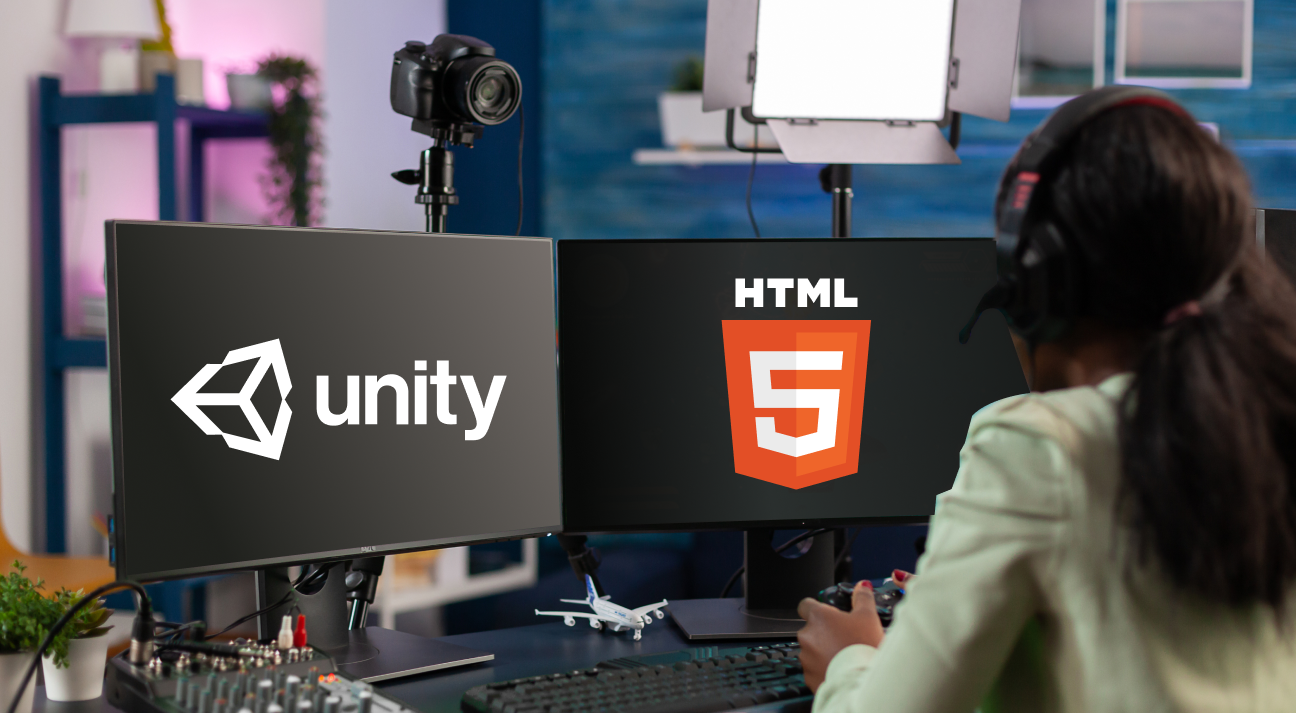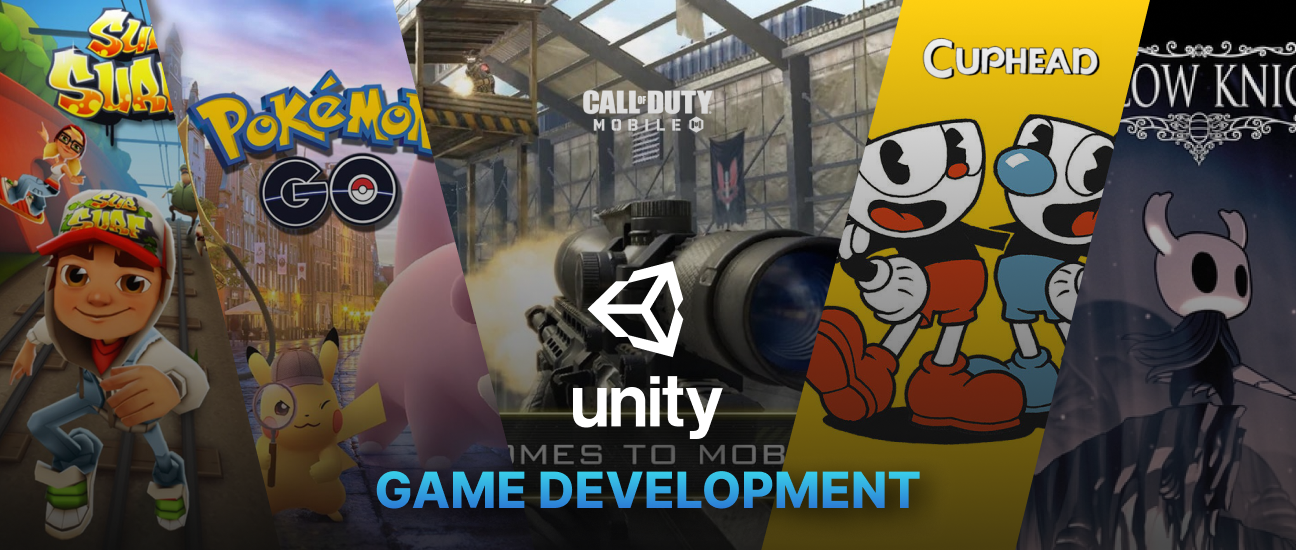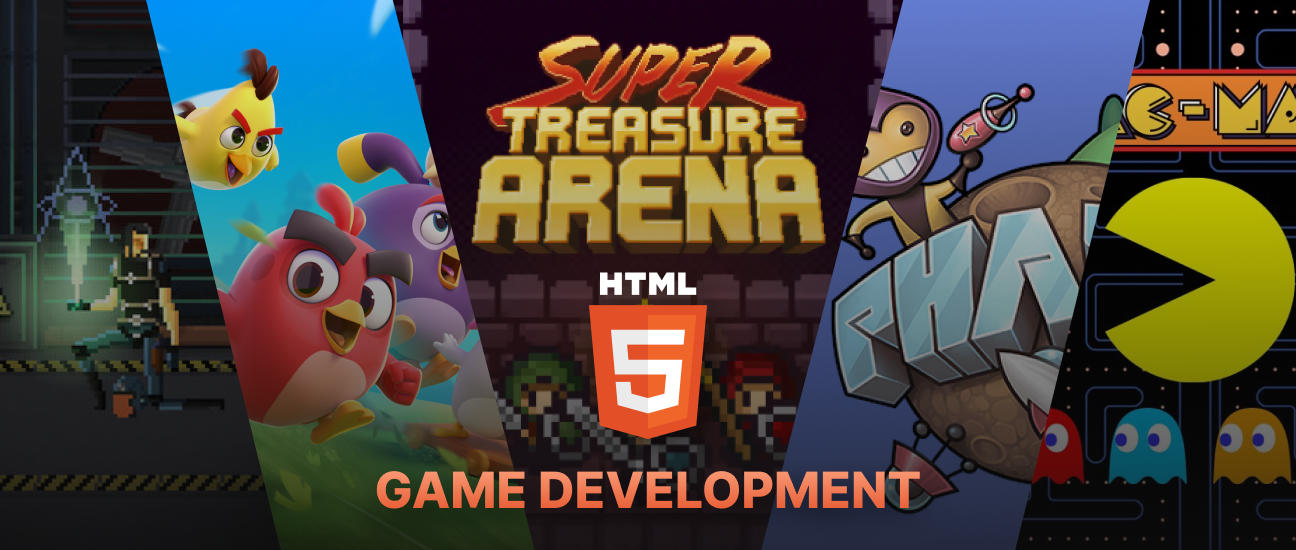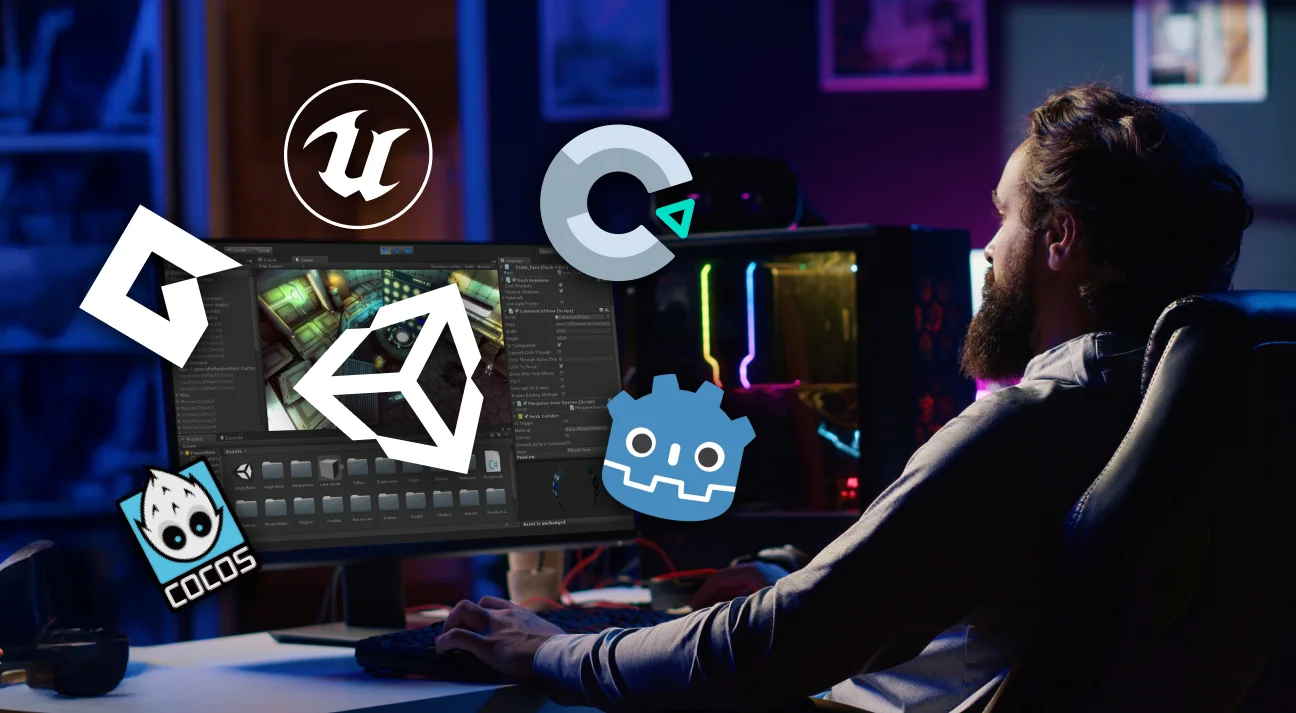
Unity 3D Vs. HTML5: Which is the Perfect Game Development Technology?
Suppose you are an artist all set to create a beautiful painting. What’s the first thing you need to start? Well, you need a canvas to start, but what type of canvas should you choose? There are many choices, and they might confuse you, but you have to pick the canvas that depicts the look and feel of your painting.
In game development, you have to think similarly and choose the best technology that works like a tool you need to create a game. This choice will decide the functionality, gameplay mechanics, user experience, etc. Usually, developers choose Unity 3D or HTML5 to develop the game. However, this pick isn’t easy and way more difficult than what meets the eye.
Despite being prominent game development technologies, they also have silver linings that you need to keep in mind while making the decision. In this blog, we have compared both technologies and outlined their crucial factors to help you make an informed decision. By the end of this comparison, you will have the knowledge to choose the technology that aligns seamlessly with your game development vision. So, read our blog on Unity 3D vs HTML5 to find the answer you have been looking for so long.
What is Unity 3D?
Unity 3D (Unity) is a versatile and feature-rich game development engine used to develop video games and interactive 2D, 3D, virtual reality (VR), and augmented reality (AR) experiences. The platform caters to a wide range of development requirements and helps with many genres, from small indie game projects to combat games.
To give a better idea, below mentioned are some of the most highlighted capabilities, advantages, limitations and previous uses of the game engine.
Core Features and Capabilities
Unity 3D boasts a extensive of powerful features and capabilities:
Asset Store
Unity has an asset store full of ready assets, like 3D models, textures, audios, and scripts that accelerate the development process.
User Friendly UI System
Unity 3D has a user-friendly UI system for creating in-game menus, HUDs, and interfaces. It streamlines front-end design and development for programmers.
Graphics and Rendering
Unity 3D provides high-quality graphics and possesses superior rendering capabilities for developing visually stunning 2D and 3D games. It supports advanced rendering techniques, dynamic lighting, and post-processing effects.
Entity-Component-System
Unity 3D’s Entity Component System architecture is a fundamental part of the game engine’s design. In this model, its features are broken down into entities (game objects), components (data and behavior), and systems (logic that operates on components). The architecture supports modularity, efficient data management, and performance enhancement and offers great flexibility.
GameObject Hierarchy
In Unity, the 3D building block is the Game Object. These GameObjects work as entities in the ECS architecture, and they are kept in a hierarchy pattern, with the main GameObject on the top. Developers can detach or attach numerous components to GameObjects to define game’s behavior, functionality, and appearance.
Pros and Cons of Using Unity 3D
Pros
- Unity 3D enables developers to build cross-platform games that run on Windows, macOS, iOS, Android, PlayStation, Xbox, Nintendo Switch, etc.
- Unity game developers can avail of monetization and earn higher revenues by integrating compelling games with available features, including advertising, in-game payments, and analytics.
- Unity’s engine is capable enough to take the support of available smartphone technologies like GPS, gyroscopes, accelerometers, etc.
- Unity 3D has a built-in physics engine that helps build realistic interactions among objects and simplifies the physics-based game development process.
- Unity is among the best platforms for AR and VR development. It offers built-in support for widely known platforms, such as AR Core, ARCore, Oculus Rift, and HTC Vive.
Cons
- Unity 3D has a steep learning curve, and novice developers have to work hard to understand the complex architecture and features.
- The game engine often requires performance optimization, especially for mobile devices. If the codes are inefficient or overused, they may not perform well.
- For large projects, asset and code management can be challenging. It demands extensive expertise, good project organization, and asset management practices.
- It needs more memory to function properly. This consumption causes OOM errors and debugging issues in smartphones.
- It doesn’t let developers load the work from the foundation or template. They have to begin from scratch without taking any added help. This practice is time-consuming and tiring at times.
Popular Games Developed Using Unity 3D

Some of the most famous games made in Unity Engine are Cuphead, Monument Valley, Rust, Pokemon GO, Hollow Knight, Beat Saber, Fall Guys, Super Mario Run, Escape Plan, Firewatch, etc.
What is HTML5?
HTML5 is the latest version of HTML (Hypertext Markup Language) for creating web pages, applications, and games. It uses CSS and JavaScript for game development. The technology gained appreciation due to its cross-platform compatibility, ease of distribution, and ability to reach a wide audience. It does not require additional software or plugin installation.
Here is breakdown of HTML5 capabilities, pros and cons, previously developed games and other information backing up the claim.
Core Features and Capabilities
Here are some core features and capabilities of HTML5:
Vector Graphics
Vector graphics help draw graphics of different types, shapes, and colors with JS scripting. Developers can easily create, edit and scale these graphics while supporting animation and interactivity.
WebGL
Web Graphics Library is a crucial component of HTML5 that provides hardware-accelerated 3D graphics rendering in web browsers. It allows programmers to develop interactive, immersive, and visually appealing 3D games and their characters, environment, effects, etc. These games support many devices without demanding any plugin installation.
Specific Gaming Tag
HTML5 has a gaming tag <canvas> for drawing 2D context that enables developers to render graphics, games, and animations in the web browser. WebGL supports its functionality and enhances its performance.
Geolocation API
Developers can use HTML5’s geolocation API to create location-based games and applications that track user’s geographic locations and coordinates accordingly.
Doctype
The feature reduces the coding and tag requirements. Developers can use doctype tag <!DOCTYPE html> to remove the virtually unreadable codes without copying and pasting code sections.
Pros and Cons of Using HTML5
Pros
- HTML5 supports all platforms and devices, including laptops, web, mobile, desktops, smart televisions, etc. It facilitates cross-platform development, simplifies distribution, and reaches a wider audience.
- HTML5 games are distributed through web links, allowing players to access games conveniently without asking for app store downloads.
- The technology can write any semantic and descriptive code cleanly. Developers can separate it in style format without putting much effort.
- It requires fewer resources to function smoothly, which improves the running speed of the game and provides seamless gaming experiences without much loading.
- HTML5 games can be monetized through various methods, including in-game advertisements, microtransactions, and selling premium versions or virtual goods.
Cons
- HTML5 games have transformed over time, but they are not as powerful as native games. Developers face struggles while building complex 3D games with high graphical demands.
- They run in web browsers, which are susceptible to potential security threats, cyber-attacks, hacking, and piracy. Developers have to take strict security measures to safeguard the game from these threats.
- HTML5 is a relatively new technology and hardly supports old browsers. It may not perform well on older browsers like IE.
- Achieving optimal performance may require extra effort and expertise, especially for resource-intensive games.
- It can be hard to manage large and complex games with HTML5. Projects with multiple features require good project and asset management skills.
Popular Games Developed Using HTML5

Till now, celebrated games like Construct 2, Phaser, PlayCanvas, CrossCode, 2048, Angry Birds, Bejeweled, Free Rider HD, etc., have been made using HTML5 as the game development technology.
Unity 3D Vs. HTML5: Which is the Best Choice?
The choice between Unity 3D and HTML5 for game development depends on your specific project requirements and goals. Here are some key considerations to help you decide:
System Setup
Unity game development often requires a more powerful system with a dedicated GPU for 3D graphics rendering. It is easy to set up for experienced developers, but novice ones might struggle more. You may have to download and install Unity Editor to leverage the available game development tools.
Along with it, you will have to install additional software, including Visual Studio for C# coding or other supported programming languages. The setup is easy, but Unity 3D is not an open-source technology. Its operations are controlled by an organization. Hence, if you face technical challenges or bugs, you will have to wait until the organization resolves them.
HTML5 game development is relatively lightweight in terms of system requirements as it does not demand local code setup or IDEs for functioning. An experienced HTML5 game development company can help create engaging and scalable games that work seamlessly across multiple devices, including low-powered systems.
It requires a text editor to write HTML, CSS, and JavaScript code. There is no need for specialized software installations. However, you need a local server to execute the setup and development process. It may be challenging to choose the perfect framework from the available ones.
Graphics Quality
Unity 3D is renowned for creating high-quality 2D and 3D graphics. It has a powerful rendering engine that supports advanced graphics features, such as dynamic lighting, real-time shadows, post-processing effects, and particle systems. Developers can also use shaders to create custom materials and visual effects and take advantage of modern GPUs to make graphics visually stunning. Hence, Unity’s graphics quality is superior.
Dissimilarly, HTML5 is not a graphics engine, but it can create graphics and animations with the help of CSS and JavaScript. HTML5 Canvas and WebGL have capabilities to render 2D and basic 3D graphics in web browsers, but they may not offer the same level of graphical fidelity as Unity.
Performance
Unity has efficacious rendering and scripting systems, and the engine has been optimized for high performance. It offers direct access to the hardware, facilitating optimal use of resources like GPU and CPU. Its compiled and optimized native code and scripting languages lead to faster execution. Unity games have the support of multi-core processors and offer smooth and consistent frame rates.
Contrary to this, HTML5 depends on web browser capabilities that may vary according to performance and support for hardware acceleration. HTML5-based games often use JavaScript for scripting, which is interpreted and may not be as performant as compiled languages. The engine faces limitations in creating real-time physics simulations, complex 3D graphics, and advanced visual effects.
Development Workflow
Unity has an integrated development environment and robust features like component construction, built-in physics, asset store, and preview debugging. It is the ultimate choice for developing high-end games with different narratives. Developers can use its specialized tools for game development, including visual scripting options (like Bolt), animation tools, and a dedicated scripting environment.
It supports multi-platform development, allowing developers to build games for various devices and platforms using a single codebase. It is the best technology for game development. However, the process becomes challenging when game logic becomes more complex and starts utilizing C#, and script-based coding that doesn’t offer too many reusable code libraries.
HTML5 is a fantastic choice for developing casual games and other less complicated games. It also offers cross-platform support and allows coding in HTML, CSS, and JavaScript using a text editor. Many developers are familiar with its technology as it doesn’t have an integrated development environment like Unity.
It also allows developers to access cross-JavaScript compilers for TypeScript and CoffeeScript, but it doesn’t have a sizable game development library and integrates with limited tools. Its development workflow is easy to learn and execute, but it is not a viable choice for developing complex games.
Ease of Publishing
Unity 3D offers built-in support for leading game platforms like iOS, Android, macOS, Windows, PlayStation, Xbox, gaming consoles, desktop, AR/VR devices, etc. Developers can publish Unity games on the Apple App Store and Google Play Store after following an easy publishing process and take advantage of its distribution strategies, network, and export options.
HTML5 games are published on the web easily by a HTML game development company. Players can access these games through web browsers without downloading or installation. These are cross-platform games and can be played on any device with a modern web browser. HTML5 games have less visibility in app stores as they are distributed through websites, shared via URLs, or hosted on web platforms.
Development Cost
Unity 3D gives free access to Personal Edition with basic features that can help develop small-scale games. You have to buy a Unity Pro licence if you need access to advanced features or want to remove the Unity splash screen. The licensing cost starts from $150/month and $1800/year. It is just a basic estimation, and the price may vary according to your chosen licence type. Also, Unity 3D game development services may cost higher due to its graphical and technical support.
Along with it, Unity 3D has an Asset Store from where you can buy game assets, scripts, and plugins. Also, it requires time and skills and demands more coding and asset creation. You will have to hire Unity 3D game development company for the work. This requirement will add to the cost.
Contrary to this, development tools like text editors and web browsers are available for free in HTML5, and there are many open-source libraries and free resources for game development. The technology also helps develop simple 2D games and interactive web content within a short duration. You may have to purchase some assets and features, but they are not as costly as Unity 3D.
On pricing upfront, HTML5 game development services are more cost-effective than Unity 3D. However, if you are developing 3D games with higher budget and more features than choose Unity 3D.
Post Production Support
Unity Technologies regularly releases updates and patches to the Unity engine, addressing bugs, improving performance, and adding new features. Unity’s LTS (Long-Term Support) versions are available for extended support and stability. Additionally, Unity has a robust and active community of developers, both within the Unity forums and on platforms like Stack Overflow. This community supports in finding solutions to common and technical issues.
It is easy to maintain HTML5 games across various browsers and platforms due to its long-term compatibility. The technology has a wide range of community resources, libraries, and frameworks to support post-production needs, bug fixes, and updates. Apart from that, HTML5 games are hosted on web servers. So, developers can make server-side updates and fix issues without asking players to download new versions.
Unity 3D is a strong choice for projects that require regular updates, advanced features, and a dedicated community. HTML5 is a suitable option for cross-browser compatible web-based games requiring rapid and server-side updates.
Which Technology Should You Choose for Game Development?
The battle of Unity 3D vs. HTML5 has ended and it is time for the results.
When to Choose Unity Game Engine:
- If You want to develop complex, 3D games that may have evolving needs and a longer life cycle.
- If you have a huge budget and your game requires advanced features and 3D graphics and animation.
- You want to create sophisticated, performance-intensive games for multiple platforms.
- You intend to target app stores and want access to specialized features like in-app purchases or advanced graphics.
- You want to build complex 2D and 3D games with advanced graphics, physics, and interactivity.
- You can hire experienced game developers to work on high budget projects.
When to Choose HTML5:
- If you want to develop simple 2D and web browser games with limited features.
- You have budget constraints.
- You want to reach a broad online audience quickly without the friction of app store submissions and installations.
- If you are planning to publish the game without much assistance.
- You don’t have the budget to hire expert team with years of experience.
- You plan to build the game quickly.
Also read: Unity vs Unreal Engine: Which One is Best For Your Game?
Develop Your Game on the Perfect Technology with 300Mind
300Mind is a wise choice if you are planning to create high-quality, feature-rich, and engaging games that can captivate players for hours. We are a reputed game development studio with years-long experience and a team of game artists with extensive expertise.
Our team understands the intricacies of game development and best practices and knows how to overcome common challenges efficiently. We choose the right technologies, development platforms, features, and tools after understanding your project requirements.
300Mind team creates stunning visuals, captivating characters, and engaging environments, enhancing the game’s appeal. Our professionals follow industry best practices for coding, performance optimization, security, and user experience. We are known for our dedication and commitment to excellence across the world. So, make us a part of your team and launch a successful game.

FAQs on Unity 3D vs HTML5
You can use both Unity 3D and HTML5 in a single game project. Unity can help develop core gameplay elements, 3D graphics, and performance-intensive features. HTML5 can help build web-based interfaces, menus, or additional interactive content for the game. This approach allows you to combine the strengths of both technologies in a single game.
HTML5 is a viable choice for developing simple 2D web browser games. It may not be able to comply with AAA game development requirements. You should choose Unity 3D for this project.
Unity 3D is known for its versatility, graphics and animation quality, custom features, technical support, etc. It can be used to develop 2D and 3D games for a wide range of platforms, including PC, consoles, mobile devices, AR/VR, web, etc. Unity 3D is a strong contender if you need to build high-end games and launch them on multiple platforms.
HTML5 can help develop casual, 2D, and simple 3D games. You can choose it if you want to reach a broad audience using web technologies. It is an ideal choice for developing smaller indie game projects or web-based games. However, for highly complex 3D games, other engines would be more suitable.








